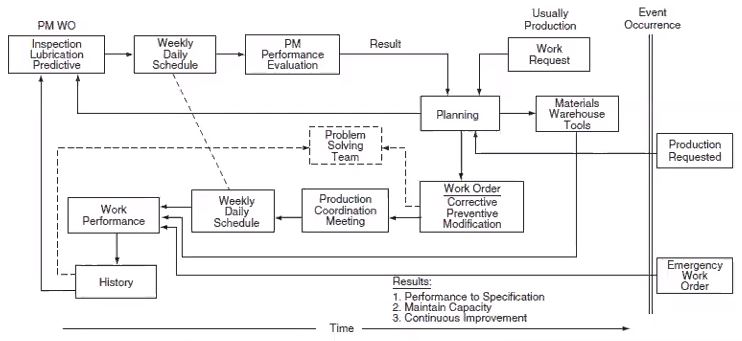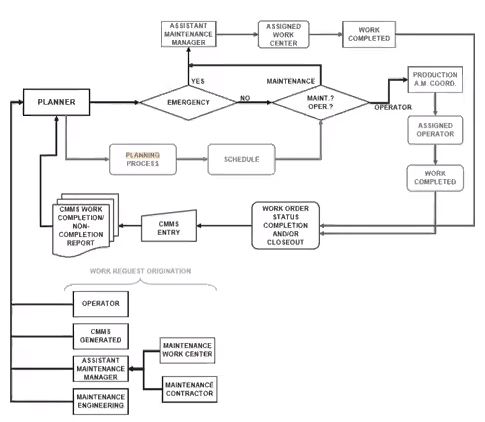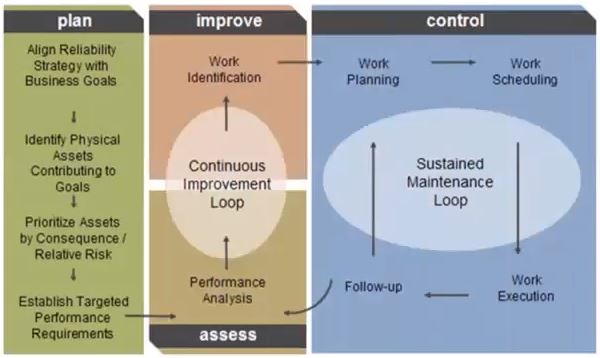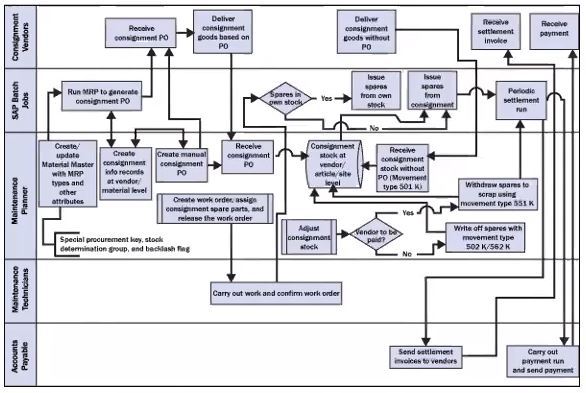What Is Maintenance Process Mapping?

As Ricky Smith points out, without effective maintenance process maps, an organization will never achieve stable maintenance processes. This statement stresses the necessity of process maps to achieve continuous improvement.
Initial Questions to Ask
Before diving in, it helps to take a step back and understand what processes are like in your organization. The first question worth asking is whether or not your organization has maintenance process maps. If you do, then here are a few more questions you might want to ask to assess the current state of your mapping process:
- Does everyone in maintenance know they exist?
- Are they followed?
- Are your process maps linked to leading and lagging key performance indicators (KPIs)?
- Do your process maps have responsibility assignment matrices (also known as RACI charts) to align everyone's actions?
Keep your responses in mind as we go through the rest of the sections. If you're not familiar with process maps or haven't heard about them before, then chances are your organization isn't using them. While having a lack of maps isn't ideal, it's not uncommon either. Here are the top reasons why organizations do not use process maps:
- No one sees the value of process maps
- Tried using process maps, but no one seemed to follow the process
- Employees did not know how to use a process map
- Thinking that process mapping is only for production processes
- Never heard of process mapping for maintenance
- "You don't know what you don't know"
These are the most common reasons you'll hear from organizations that do not have process maps in place. Some haven't even heard about it, and to add to the last point, they have no idea what they're missing. Maintenance process mapping aligns everyone in an organization in terms of their thinking and their execution process. In the next section, we'll take a closer look into what exactly constitutes this process.
What Is Process Mapping?
Process mapping is a technique of using flowcharts to illustrate the steps of a process. It proceeds from the highest-level macro perspective to the most detailed level required to identify opportunities for improvement.
Process mapping focuses on the work and the required tasks, rather than job titles or hierarchies. Ultimately, the purpose of process mapping is for organizations to improve efficiency. It does so by providing insight into the nitty-gritty of processes and their procedures. It enables teams to brainstorm ideas for process improvement while increasing communication and process documentation. Through these steps, process mapping further helps with identifying bottlenecks, repetitions, and delays.
Process Mapping Examples
Process maps can take a variety of shapes and forms. Here are a few process mapping examples developed throughout the past few decades:
1. Alumax Mount Holly (1978)
Mount Holly was a large aluminum smelter that employed world-class maintenance systems. The process map shows how a proactive approach to maintenance resulted in higher levels of reliability.

2. Lean Maintenance (2005)
The next example is from the book, Lean Maintenance. As the name of the book implies, this does not use a lot of different characteristics. Instead, it features a lean process map for all processes.

3. Rules of Thumb for Maintenance and Reliability Engineers
The next example has a process map that moves across the main sections named plan, improve, assess, and control. The typical flow of this map incorporates two main loops: the Sustained Maintenance Loop and the Continuous Improvement Loop. It recognizes the importance of repetition and evaluation in improving existing processes.

4. Process Maps with Swim Lanes
Swim lanes are effective in visually identifying the groups of people or accountable units for each step of the process. Each swim lane represents a category or classification of people to which the task belongs.

Benefits of Mapping a Maintenance Process
At the beginning of the article, we mentioned how process maps are essential to achieve continuous improvement. That might sound like a tall order to expect from such a straightforward process diagram. However, the importance of mapping becomes more evident once we identify its key advantages. Here are some benefits of mapping your maintenance processes:
Aligns Everyone's Vision
Each stakeholder will look at maintenance differently. A maintenance manager's approach to seeing the value of maintenance will perhaps be different from the production manager's perspective. Mapping maintenance processes aligns everyone's vision of the value of the process. All stakeholders from maintenance, planning, and even production teams can come together on the same page.
Ensures Everyone Follows the Same Steps
A lot of steps are involved between work identification and closeout. Depending on the size of operations, the steps further multiply as the number of teams and work centers increases. Having a clearly defined maintenance process map ensures that everyone follows the same steps regardless of where they are in the procedure.
Systematically Identifys Issues
If you have your maintenance process mapped, you gain a better sense of whether or not your metrics are aligning with what's happening on the floor. At the earliest signs of issues, you can refer to your process map and perform root cause analysis methods. You can engage in a brainstorming exercise with the team while having confidence that you're all aligned to the same vision.
Steps for Mapping the Maintenance Process
The maintenance mapping process can be intimidating to take on, especially for someone who has never heard of such a device. The next section outlines the general steps for mapping your organization's maintenance processes. Whether your team is just getting into process maps or have been using them for quite some time, these steps surely provide valuable insight.
1. Determine Your Maintenance Cost Trend
The first step of the process is knowing your cost trend. Your cost trend refers to labor and material costs for the past five years. Different stakeholders might have varied opinions on what makes up the trend. A key part of this step is getting everyone on board and satisfied - from the maintenance technician level up to the management level.
2. Create a Team of Key Stakeholders
The next step is creating and identifying key stakeholders. A typical list of stakeholders includes the following:
- Facilitator
- Maintenance manager
- Maintenance supervisor
- Senior maintenance technician
- Maintenance planner or scheduler
- Store manager
- Production manager
The specific people who take on these roles might be different for each organization. For example, a facilitator, someone with no stake in the outcome, could be an outside resource such as a consultant. The facilitator may not necessarily be a maintenance expert. Moving down the list, the senior maintenance technician could be someone from the team who acts as an influencer. For that role, someone who has extensive maintenance experience is favorable. Ideally, the senior technician is someone who has a proactive approach to maintenance that can see the bigger picture.
3. Educate the Key Stakeholders About Maintenance Best Practices
Maintenance best practices, also known as world-class maintenance, are demonstrated practices accumulated over the years, across multiple industries. Given the data and evidence available, these practices provide a framework of standards that are shown to drive performance.
4. Educate the Team About the Value of Mapping the Maintenance Process
Knowing the value of maintenance process maps aligns the team towards a common goal. By educating all stakeholders about the importance of mapping processes, everyone can think and act the same way.
5. Create a RACI Chart
There are four responsibilities defined in a RACI chart. RACI stands for these categories: responsible, accountable, consulted, and informed. Creating a responsibility assignment matrix clearly defines the roles of each stakeholder. In other words, everyone knows the tasks for which they are accountable.
For example, when writing a procedure manual, a maintenance technician might be responsible for completing the document. The technician's line leader, such as the maintenance manager, could be the one accountable for producing the manual. In the same example, the maintenance engineer or reliability engineer typically acts as a consultant, while other relevant members of the team are informed.
6. Create a Plan
When creating a plan, it's best to use the crawl-walk-run methodology. Crawl first and start slow and steady. Sustain the progress until you're comfortable picking up the pace. As you gain experience, knowledge, and momentum, you'll eventually run in executing your plan.
7. Identify High-Level Maintenance Process Maps
High-level maintenance process maps are tools that guide the process from start to finish. While there may be a need for specific steps for certain tasks, a high-level map serves as a baseline or foundation. The good news is that there are plenty of free templates available on the internet to help you get started.
8. Identify Leading and Lagging KPIs
This step stresses the importance of identifying KPIs for all maintenance process steps - from work identification all the way to work order closeout. The only way for teams to know their progress is by having indicators to measure. Because every step of the process looks different, it makes sense that they potentially require different sets of KPIs.
9. Meet Your Team
After going through all the other steps, the next course of action is to meet the team. These meetings don't need to be lengthy and could typically run for 10-30 minutes. The agenda includes weekly progress reports, any constraints or roadblocks, and other general updates.
Tips for Developing a Maintenance Process Map
When rolling out maintenance process maps for the first time, you can expect to have mixed reactions from your team. It helps to reinforce positive thinking to get the most success. Here are a few tips to help your team appreciate the value and practical benefits of process maps.
Keep It Simple
You want to start with a simple process, one that's not too complicated. Gather any of your available resources and think about how you want to start at a high level. You can drill down into the details as you start learning. As we've mentioned earlier, you want to first learn how to crawl before you can run.
Think of Your Audience
The level of complexity of your process maps depends on your intended audience. For example, it would be ideal to keep the maps at a higher level if intended to be used by maintenance technicians. You could always keep more detailed versions of your maps in case anyone wants to take it to the next level.
Maximize Your CMMS
There are several places you can store your process maps. If your CMMS allows you to store process maps, then that should be your first choice. That way, you and your stakeholders can access them easily. If you're unsure, you can always check with your CMMS provider.
Explore Available Tools
If you haven't made process maps before, it could be challenging to find templates and programs that allow you to create the maps. Feel free to take a look at the sample templates in this article as a starting point. To make the actual diagrams, you can then explore available flowcharting software online. If you already have it installed, Visio is also a pretty handy program to use.
Have a Policy for Managing Change
You want to treat your process maps as a living document. You should have a policy that governs when your maps are due for review. Companies typically review their process maps at least once a year. Also remember to clearly identify the person who will perform the review, such as the reliability or maintenance engineer.
Conclusion
Maintenance process maps are essential for organizations that are seeking continuous improvement. To refine your current processes, you first need to stabilize and standardize your procedures. Building systematic process maps enables you to keep track of your methodology, thereby allowing you to identify opportunities to improve.
4,000+ COMPANIES RELY ON ASSET OPERATIONS MANAGEMENT
Leading the Way to a Better Future for Maintenance and Reliability
Your asset and equipment data doesn't belong in a silo. UpKeep makes it simple to see where everything stands, all in one place. That means less guesswork and more time to focus on what matters.

![[Review Badge] Gartner Peer Insights (Dark)](https://www.datocms-assets.com/38028/1673900494-gartner-logo-dark.png?auto=compress&fm=webp&w=336)
